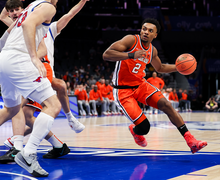MLS commissioner discusses the future of American soccer at University Lecture
Zach Barlow | Asst. Photo Editor
(From left) Rick Burton, a professor of sport management at SU, and Don Garber, commissioner of Major League Soccer, spoke Tuesday in Hendricks Chapel about some of the challenges and opportunities MLS currently faces.
Don Garber licked his finger and pointed it in the air.
“You don’t just go like this and come up with something smart,” he said.
For Garber, the commissioner of Major League Soccer, it’s difficult to devise strategies for how to manage the highest level of professional soccer in the United States and Canada. With 17 teams in the U.S. and three in Canada, MLS soccer has grown mightily since its inception in 1993.
While he said he’s happy with the progress MLS has made, Garber is looking at the future of the league five, 10 and 20 years from now. That was the main focus of Garber’s address to the Syracuse University community on Tuesday night in Hendricks Chapel as part of the University Lectures Series.
“The league is doing very well, but we have a lot of work to do,” Garber said.
The discussion was moderated by Rick Burton, a professor of sport management in the David B. Falk College of Sport and Human Dynamics. Burton asked a series of questions on topics such as the recent FIFA scandal, how MLS targets its fans and how it develops its players.
Garber became MLS commissioner after a 16-year career with the National Football League, where he finished as senior vice president of NFL International. When Garber became MLS commissioner in 1999, the league comprised 10 teams, he said. Now, the league has 20 teams across the U.S. and into Canada. In 2014, Garber helped MLS secure media rights with ESPN, Fox Sports and Univision Deportes, he added.
Five former SU men’s soccer players have been drafted by MLS teams in the last two years. In January, former SU standouts Julian Buescher and Ben Polk were selected in the first round of the MLS SuperDraft by D.C. United and the Portland Timbers, respectively. The pair helped SU reach the Final Four in 2015.
Garber began the discussion by saying he’s proud of the way MLS handled the FIFA corruption scandal, which erupted last year after U.S. authorities disclosed cases of corruption.
When Garber licked his finger and pointed it in the air, he was referring to MLS’s challenge of attracting a younger audience. Millennials want an urban experience, he said, where they can take the subway or ride a bike to the game. Many millennials grew up with soccer and can relate to it more than people of older generations, he added.
“It is a sport for this new America,” Garber said. “I wholeheartedly believe you are consuming it in different ways than your parents did.”
How consumers get to games, buy tickets and consume content are just some of what MLS is researching, he said. On a similar note, Garber later outlined MLS’s analytics strategies. In practice, every player wears a small monitor on the back of his jersey to help researchers examine fitness levels, among other measurements, he said.
“We have to improve quality of play,” he said. “How long it takes a player to touch and distribute, scoring percentages, (we) have been tracking that. People sit in an office looking at (that) in real and post time, taking all that information, spinning it out.”
He also touched on MLS’s theme of driving a soccer nation in America. The soccer culture, he said, is what makes the sport different. He said proud fans, such as those who stand in pouring rain for 90 minutes to watch their favorite team, are special.
One of Garber’s biggest challenges is developing and retaining world-class players, he said. In the U.S., the traditional trajectory is for soccer players to attend college and work toward a degree while playing the game. Elsewhere around the globe, though, players become professionals at younger ages, he said.
To fix that, MLS has begun to invest more in academies starting at age 14. Garber said teams are spending upwards of $8 million to $10 million a year in player development.
“It’s going to take time before we develop players as good as the Germans,” he said. “Belgium has a cultural dynamic that we don’t yet have. How do you have (a) player think about nothing else but the team when they’re 16? That culture doesn’t yet exist and it will take some time before that happens.”
Garber also talked about MLS’s expansion into new cities, virtual reality and the FIFA soccer video game’s impact on MLS and soccer overall.
Published on March 23, 2016 at 1:02 am
Contact Matthew: mguti100@syr.edu | @MatthewGut21





